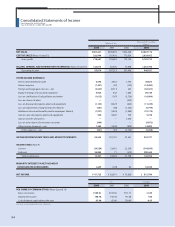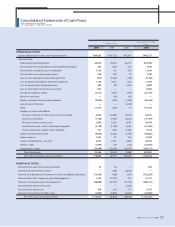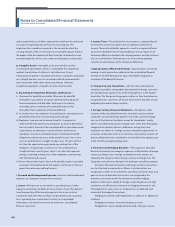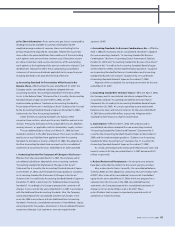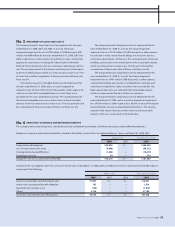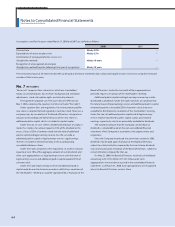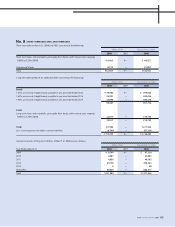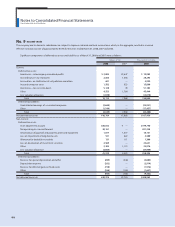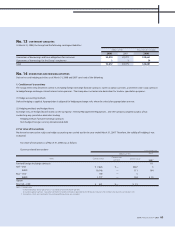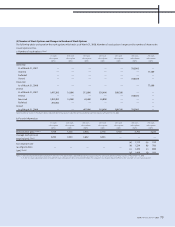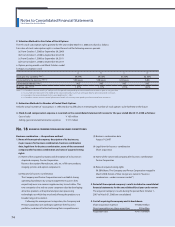Pentax 2008 Annual Report Download - page 66
Download and view the complete annual report
Please find page 66 of the 2008 Pentax annual report below. You can navigate through the pages in the report by either clicking on the pages listed below, or by using the keyword search tool below to find specific information within the annual report.
Notes to Consolidated Financial Statements
Hoya Corporation and Subsidiaries
No. 7 NET ASSETS
“Net assets” comprises four subsections, which are shareholders’
equity, accumulated gains (losses) from revaluation and translation
adjustments, stock subscription rights and minority interests.
The Japanese Corporate Law (“the Law”) became effective on
May 1, 2006, replacing the Japanese Commercial Code (“the Code”).
Under Japanese laws and regulations, the entire amount paid for
new shares is required to be designated as common stock. However, a
company may, by a resolution of the Board of Directors, designate an
amount not exceeding one-half of the price of the new shares as
additional paid-in capital, which is included in capital surplus.
Under the Law, in cases where a dividend distribution of surplus is
made, the smaller of an amount equal to 10% of the dividend or the
excess, if any, of 25% of common stock over the total of additional
paid-in capital and legal earnings reserve must be set aside as
additional paid-in capital or legal earnings reserve. Legal earnings
reserve is included in retained earnings in the accompanying
consolidated balance sheets.
Under the Code, companies were required to set aside an amount
equal to at least 10% of the aggregate amount of cash dividends and
other cash appropriations as legal earnings reserve until the total of
legal earnings reserve and additional paid-in capital equaled 25% of
common stock.
Under the Code, legal earnings reserve and additional paid-in
capital could be used to eliminate or reduce a deficit by a resolution of
the shareholders’ meeting or could be capitalized by a resolution of the
Board of Directors. Under the Law, both of these appropriations
generally require a resolution of the shareholders’ meeting.
Additional paid-in capital and legal earnings reserve may not be
distributed as dividends. Under the Code, however, on condition that
the total amount of legal earnings reserve and additional paid in capital
remained equal to or exceeded 25% of common stock, they were
available for distribution by resolution of the shareholders’ meeting.
Under the Law, all additional paid-in capital and all legal earnings
reserve may be transferred to other capital surplus and retained
earnings, respectively, which are potentially available for dividends.
The maximum amount that the Company can distribute as
dividends is calculated based on the non-consolidated financial
statements of the Company in accordance with Japanese laws and
regulations.
Since the Company introduced the committees system in 2003,
dividends may be paid upon resolution of the Board of Directors,
subject to certain limitations imposed by the Law. Interim dividends
may also be paid upon resolution of the Board of Directors, subject to
certain limitations imposed by the Law.
On May 22, 2008, the Board of Directors resolved cash dividends
amounting to ¥15,150 million ($151,213 thousand). Such
appropriations have not been accrued in the consolidated financial
statements as of March 31, 2008. Such appropriations are recognized
when the Board of Directors resolves them.
2008
Discount rate
Expected rate of return on plan assets
Amortization of unrecognized prior service cost
(Straight-line method)
Recognition of unrecognized acturial gain
(Straight-line method from the following fiscal year of recognition)
Mainly 2.0%
Mainly 3.5%
Mainly 10 years
Mainly 10 years
2007
—
—
—
—
Assumptions used for the years ended March 31, 2008 and 2007 are set forth as follows:
The estimated amount of all retirement benefits to be paid at the future retirement date is allocated equally to each service year using the estimated
number of total service years.
64


